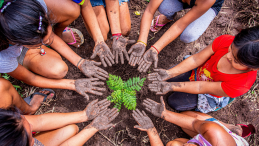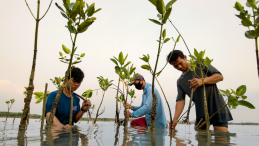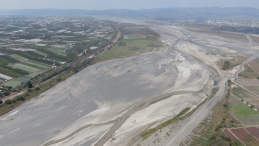Disaster risks are increasing, but so are the solutions being developed to reduce them. From rethinking our societies to social protection and finance, nature-based strategies, mountain resilience and drought adaptation, research from UNU-EHS scientists is helping us better understand risks and build pathways toward safer, more sustainable futures. Here are five recommended reads that show how science can guide action in a world where resilience has never been more urgent:
Interconnected Disaster Risks: Turning Over a New Leaf
Climate change, biodiversity loss, pollution and inequality are intensifying. We know what we need to do, so why are we not doing it? Previous editions of the Interconnected Disaster Risks report have analysed how the disasters we see are interconnected, and what risk tipping points we are going to reach if humanity continues to weaken the systems we all depend on. The 2025 Interconnected Disaster Risks report discusses five fundamental changes we can make in our societies to reduce risk: rethink waste, realign with nature, reconsider responsibility, reimagine the future and redefine value.
Nature-based Solutions for Comprehensive Disaster and Climate Risk Management Toolkit
Nature can be our greatest ally in reducing disaster and climate risks, but only if we recognize and embrace its potential. The CRM-NbS Toolkit shows how: by linking the Sendai Framework for Disaster Risk Reduction and the Paris Agreement, it offers five practical tools. These focus on compiling local knowledge, mapping policy gaps, selecting interventions, engaging stakeholders and learning from global success stories. Together, they form a roadmap for turning Nature-based Solutions into policy and practice.
World Drought Atlas
Drought is more than a lack of rain. It is a risk that triggers other risks and ripples through water, food, energy, ecosystems and even transport. The Atlas unpacks this complexity and reveals how interconnected systems amplify drought impacts and threaten progress toward the Sustainable Development Goals. With conceptual models, case studies and visuals, the Atlas highlights where we are most vulnerable and points to possible solutions for adapting. More than a map, it is a guide for action that can help decision-makers, communities and scientists turn knowledge into resilience.
Safeguarding Mountain Socioecological Systems: Building Transformative Resilience in Mountain Regions Worldwide
While we are currently in the year designated as the International Year of Glaciers’ Preservation, mountain communities are increasingly at risk from pressures such as climate change, population growth and unsustainable resource management. This book provides an overview of existing efforts toward sustainable development in global mountain areas, presents an overview of the latest scientific findings in mountain research. It also introduces organizational structures and networks established over the past decades to allow improved integration of scientific results into decision-making and implementation on the ground.
Social Protection, Risk Finance and Insurance
As climate risks are rising and disasters are striking harder and more frequent, social protection systems risk being left behind. But what if finance itself could become protection? This Policy Note explores how integrating Climate and Disaster Risk Finance and Insurance (CDRFI) into social protection can turn pre-arranged payouts into pre-arranged delivery to help people when they need it most. Drawing lessons from developing countries in Central America, Asia and Africa, it sets out a four-pillar framework for building shock-responsive systems that are fast, fair and inclusive.





